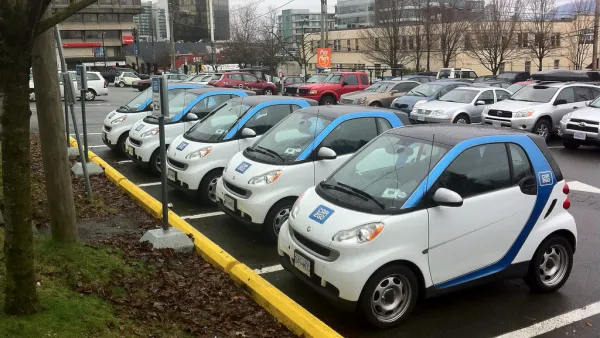A new Transit Center report shows what it takes to enact change.

According to the report, "A People’s History of Recent Urban Transportation Innovation," six cities stand out as innovators in the movement to redesign city streets for people, not cars: New York City, Portland, Chicago, Pittsburgh, Denver, and Charlotte. After half a century of building a national transportation infrastructure almost exclusively focused on accommodating automobiles, over the past decade cities across the country have shifted course, redesigning streets and public spaces for pedestrians and cyclists.
"While this may not seem 'innovative' in the technological sense, that cities would introduce bike lane networks, public plazas, mini-parks, and bikeshare wholesale onto American streets was inconceivable as recently as 2005," the report states.
How did they do it? Sandy Smith describes a three-tiered structure of roles, with citizens at the top. Citizen groups and local planning groups draw up the plans, raise public awareness and elect politicians. The relationship between the mayor’s office and constituents is critical. "By offering candidates energized blocs of voters, the advocates give politicians an opportunity to incorporate innovative thinking on urban mobility into their larger policy agendas," Smith writes.
Smith points out that the local bureaucrats tasked with implementing policies are stakeholders as well. Further, these are the people with the knowledge and savvy to design practical solution models for other cities to emulate. National movements such as the Vision Zero Network will rely on the expertise gained by local civil servants and devise broader strategies based on their successes and failures.
FULL STORY: Tracing the Urban Transportation Revolution

Analysis: Cybertruck Fatality Rate Far Exceeds That of Ford Pinto
The Tesla Cybertruck was recalled seven times last year.

National Parks Layoffs Will Cause Communities to Lose Billions
Thousands of essential park workers were laid off this week, just before the busy spring break season.

Retro-silient?: America’s First “Eco-burb,” The Woodlands Turns 50
A master-planned community north of Houston offers lessons on green infrastructure and resilient design, but falls short of its founder’s lofty affordability and walkability goals.

Test News Post 1
This is a summary

Analysis: Cybertruck Fatality Rate Far Exceeds That of Ford Pinto
The Tesla Cybertruck was recalled seven times last year.

Test News Headline 46
Test for the image on the front page.
Urban Design for Planners 1: Software Tools
This six-course series explores essential urban design concepts using open source software and equips planners with the tools they need to participate fully in the urban design process.
Planning for Universal Design
Learn the tools for implementing Universal Design in planning regulations.
EMC Planning Group, Inc.
Planetizen
Planetizen
Mpact (formerly Rail~Volution)
Great Falls Development Authority, Inc.
HUDs Office of Policy Development and Research
NYU Wagner Graduate School of Public Service



























